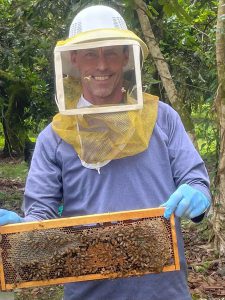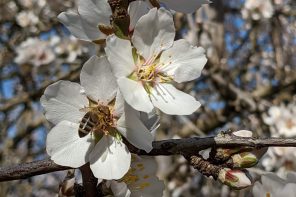My ski patrol boss Art said, “So your talk tonight is on the history of bees?”
“It’s on pesticides and bees,” I said.
“That would be the history of bees,” he quipped.
Last Fall when the Aspen Center for Environmental Studies (ACES) invited me to give a winter talk on neonicotinoids and pollinators, I didn’t exactly jump at the opportunity. I was ready to say no, just can’t, don’t have the time, when my gal Marilyn intervened. “Just do it,” she said. “You’ll learn a lot, and you like public speaking. You won’t regret this.”
All easy for her to say. I keep taking on more stuff, even though there are still only 24 hours in a day. But she was right that in my heart of hearts I relished an opportunity to research this controversial topic, and let’s face it, she can talk me into about anything.
Neonicotinoids, or “neonics,”are the relatively new class of pesticides that make plants toxic to insects. They express their insecticidal properties throughout the plant, including the nectar and pollen it produces. They have very low mammalian toxicity, but they’re hell on insects.
These chemicals can be applied as a seed coating, by foliar spray or ground application. Eighty percent of the 75 million acres of corn planted each year in this country sprouts from seed coated with neonics.
Neonics build up in the soil and in water. United States Geological Service studies in 2014 and 2015 documented these pesticides in half of waterways tested in the U.S. and Puerto Rico, with sky-high concentrations in streams in the Corn Belt.
As you might expect, reaction from the environmental community has been shrill, with demands that the Environmental Protection Agency (EPA) ban these pesticides until it’s proven they are not an environmental threat.
Among beekeepers, you’d think opposition to neonics would be a slam dunk. Think again. Some, especially within the commercial ranks, question if this is a serious problem. And while some commercial beekeepers blame the neonics for catastrophic colony losses, other beekeepers seem unaffected. Beekeeping thrives in the Corn Belt. Canadian beekeepers continue to make bumper honey crops on canola raised from neonicotinoid-coated seed. Hive numbers worldwide have stabilized, and migratory beekeeping is alive and well. What’s the problem?
The Bayer and Monsanto corporations would have you believe their products are bee-friendly, that the blame for colony losses lies primarily with beekeepers’ failure to control Varroa mites.
A lot of farmers fall right in line with the chemical companies. Just plant the magic seed. Your GMO corn grows straight and tall. It tolerates the Roundup you use to keep down the weeds. The money’s good. The bees will do fine.
I walked into this with no pre-conceived notions. The Internet deluged me with “information.” I had to pick and choose. I elected to ignore reports presented by any person or organization that appeared to have an agenda. I naturally gave weight to the opinions of well-known bee researchers whom I already knew by reputation. So when I learned that Dennis vanEnglesdorp from the University of Maryland stated, “I am not convinced that neonics are a major driver of colony loss,” I took notice.
I looked for research that drew cautious, not sweeping, conclusions, and I paid special attention to research results that might rile both environmentalists and industry advocates .
So I gave the Environmental Protection Agency (EPA) the benefit of the doubt, to a point.
On January 6, the EPA released a draft report concluding that the neonicotinoid chlothianidin weakens or kills honey bees when levels exceed 25 parts per billion in nectar. At levels below 25 ppb, it has no apparent effect. They found no middle ground. The EPA found chlothianidin safe for honey bees when applied to most vegetables, berries, tobacco, and corn. However, in cotton and citrus they decided it was a problem.
But maybe the EPA put its foot in its mouth when it declared honey bees “a good surrogate for all pollinators.”
Marla Spivak at the University of Minnesota argues that vitellogenin produced in the heads of nurse honey bees detoxifies pesticides in pollen before that pollen is fed by those nurse bees to brood. In contrast, native-bee brood consumses pollen directly, with no vitellogenin to buffer it.
A study at Lund University in Sweden found that chlothianidin in canola had no effect on honey bees but retarded the growth and reproduction of bumblebees and reduced the numbers of wild bees!
A French study found that trace amounts of neonics reduced bumblebee reproduction by 85 percent.
Research at the University of Minnesota concluded that the neonicotinoid imidicloprid harms Monarch butterfly larvae.
We know that bumblebee numbers worldwide are tumbling. And the other wild bees? Who knows? Iconic honey bees, bumblebees, and Monarchs have their advocates. But where would you find funding to study honey bees’ obscure but more vulnerable cousins?
I am not an expert, but I am a concerned beekeeper. The tentative conclusion that I drew from my research is that the neonics are probably not a major threat to honey bee health, but that these pesticides are decimating our native pollinators.
That’s the message I took to my listeners at my ACES talk. The talk was well attended by the local environmental community. Only one gentleman gave me a hard time. That’s O.K. I just called it like I saw it.








